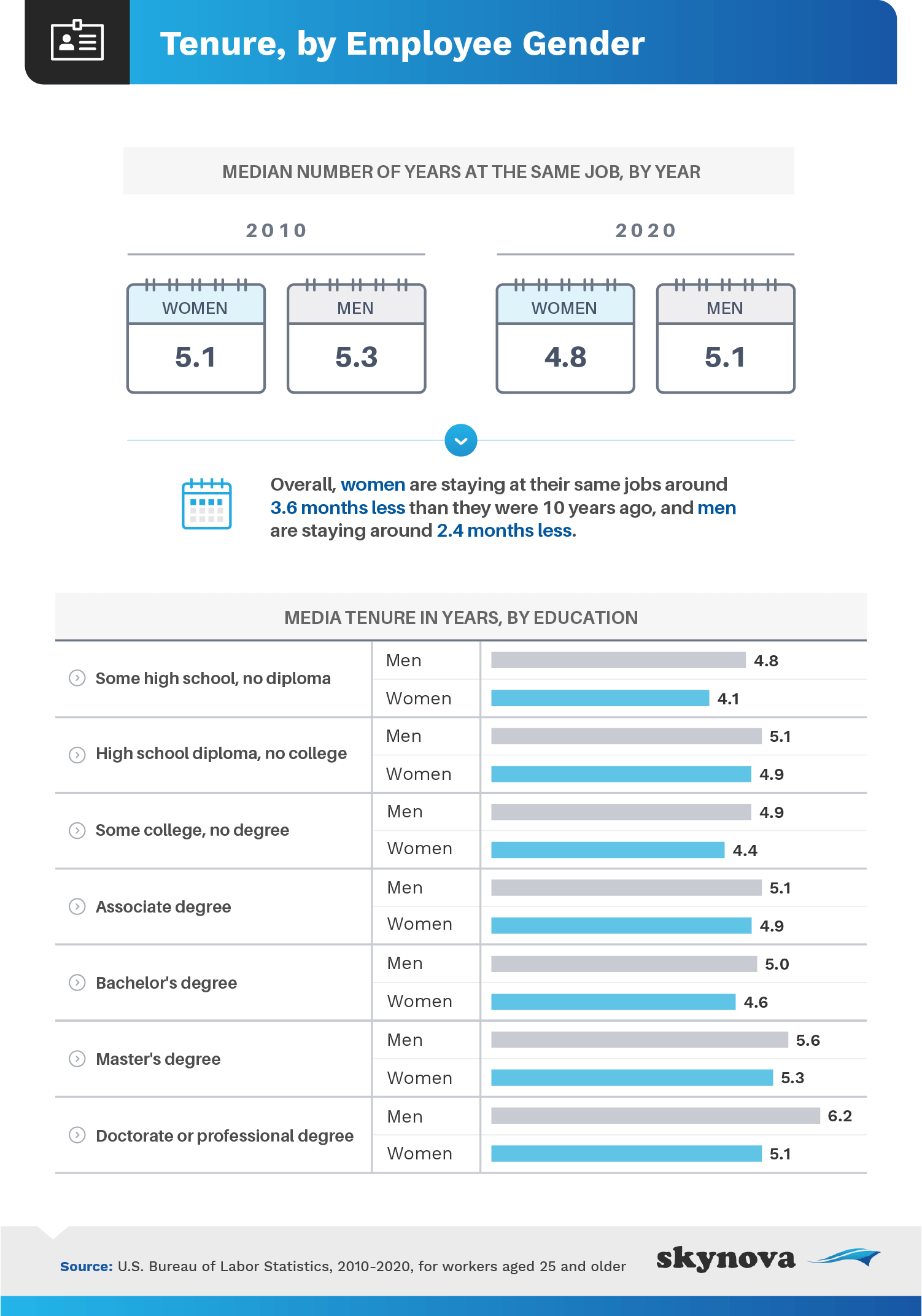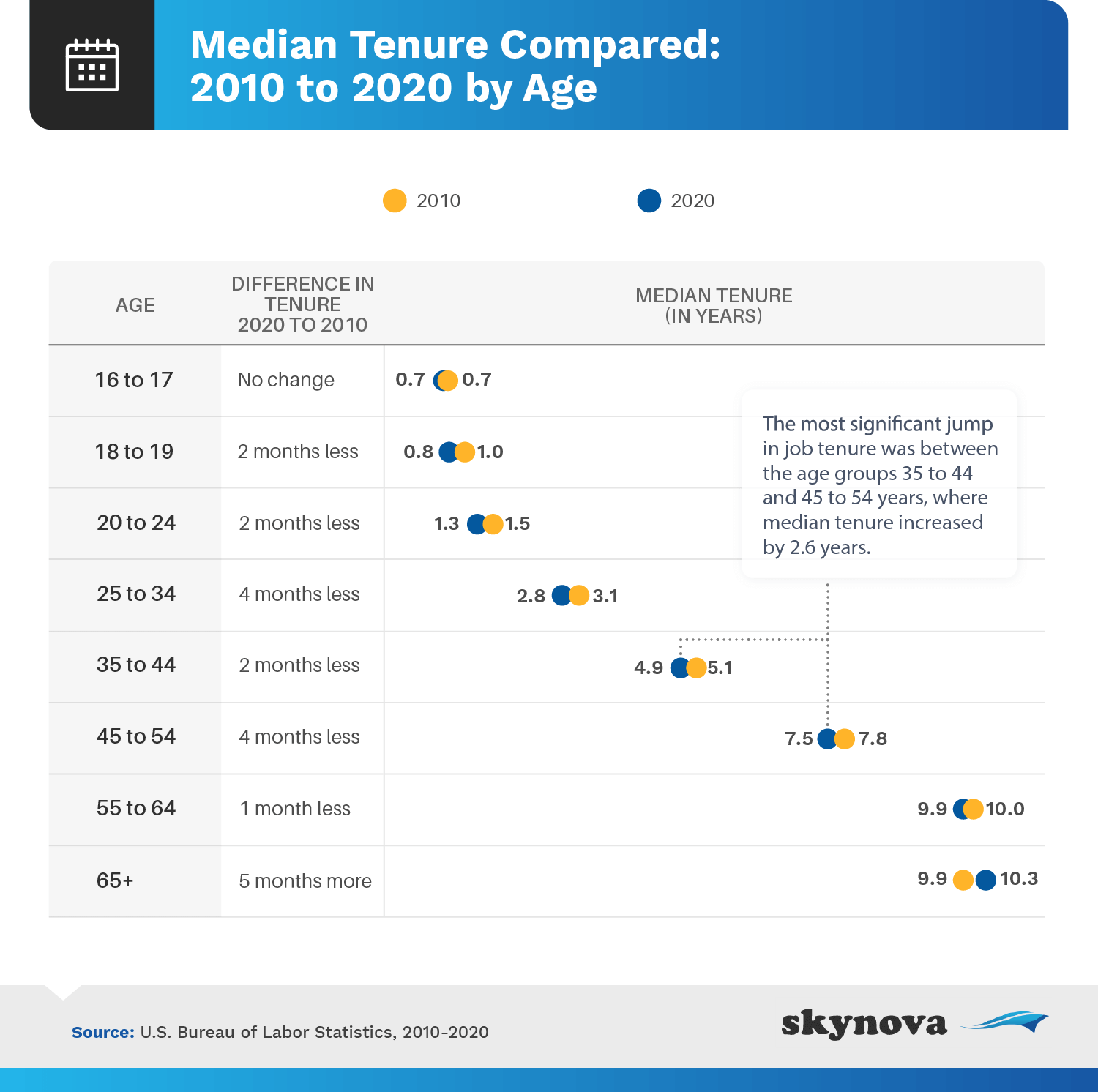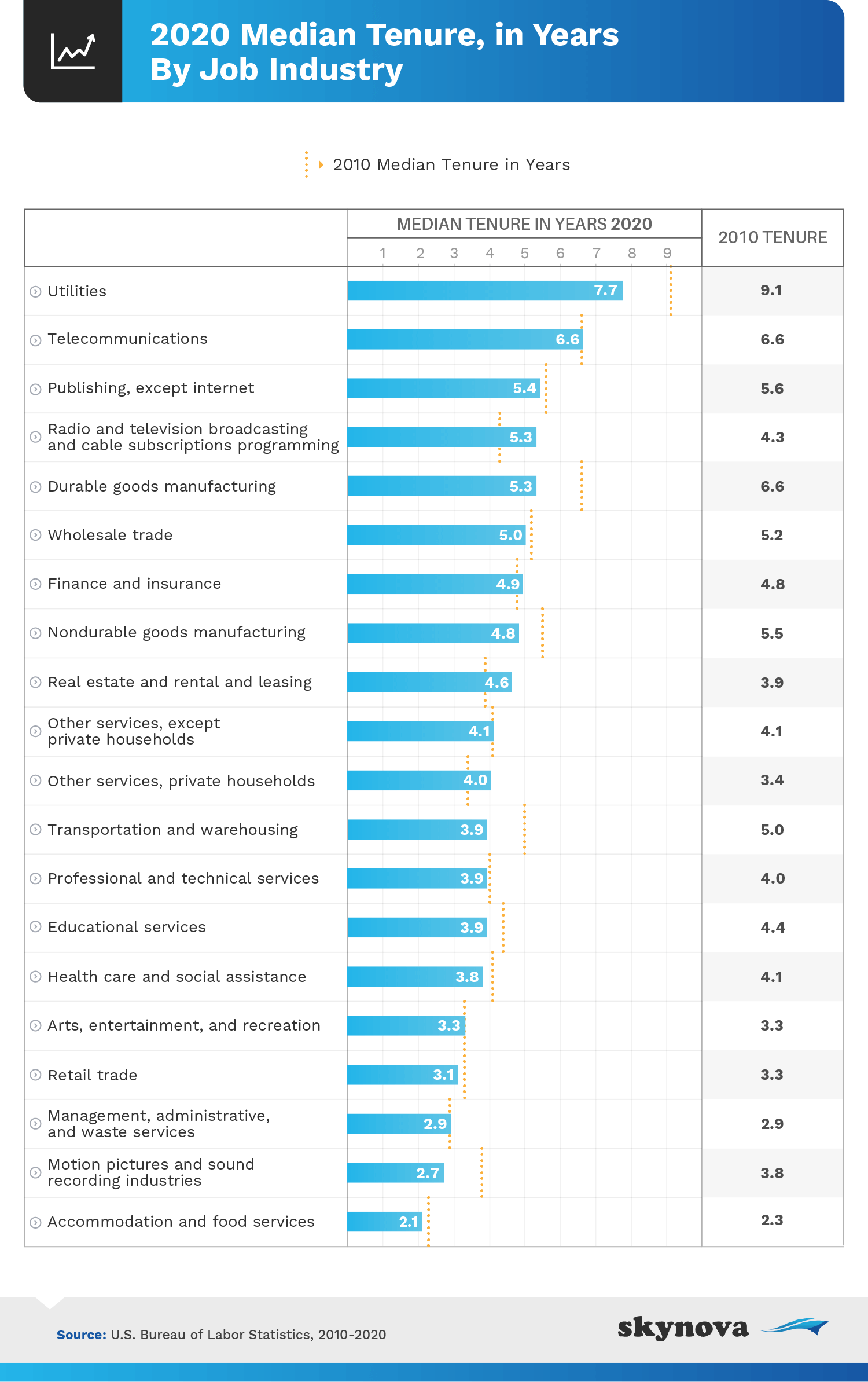
|
For many years, younger Americans have earned a reputation as "job hoppers." Both millennials and Generation Z employees have been characterized as getting bored in their existing positions and jumping from company to company to find job satisfaction and engagement. By some estimations, higher rates of turnover among millennials specifically can cost the U.S. economy $30.5 billion every year.
But age alone may not be the only factor in determining where higher rates of turnover exist among American workers, particularly in 2020 amid the pandemic recession.
For a closer look at job tenure in the U.S., we examined data from the U.S. Bureau of Labor Statistics (BLS) in 2010 and again from 2020, focusing on how long Americans stay in their jobs before finding new opportunities. Read on as we explore whether men or women are more likely to be more tenured, which industries see the highest turnover, and how these trends changed over the course of a decade.
In 2020, both men and women are spending less time in the same job positions than they did a decade ago.
While compensation can be a major consideration in where to work, pay rate isn’t the only reason Americans may consider switching jobs. Taking on a new position can help you grow, feel more challenged, and generally be happier with the work you do. Women were more likely to switch jobs and had a median tenure of 4.8 years at the same job, compared to men who stayed just a little over 5 years. Particularly during the pandemic, women were far more likely to have expressed interest in leaving their job based on changes to their work experience in 2020. As one study found, women expressed lower workplace satisfaction during the pandemic than men and anticipated lower productivity over the next year. And while both men and women will be looking for employment opportunities that offer greater flexibility in the future, working mothers may be struggling even more with new challenges to child care while working from home.

The number of years an employee stayed at their job varied by their level of education, but this factor was even more varied when viewed by gender. The statistics from the BLS shows that the more educated male workers were, the longer their tenure at a single job. But that relationship wasn’t as strong across female workers by their education level, where women with an associate degree had the same tenure as women with no college education at all.
Among both men and women, tenure was lowest, on average, among high school graduates without college experience. And while employees with a master’s degree or a doctorate had the highest tenure, women with these levels of education spent less time in their roles compared to men, including a full year less among women with a doctorate or professional degree.
Younger generations have a reputation of jumping from job to job. According to data from the BLS, employees under the age of 34 spend the least amount of time in the same job, and their average tenure is shrinking in 2020 compared to 2010.

Compared to 2010, 18- to 24-year-old employees are spending two months less in the same job, averaging between 8 months and 1.3 years. Employees between the ages of 25 and 34 are spending 4 months less in the same position, compared to 2010 – averaging 2.8 years in one job before moving on to something new.
Employees aged 35 and older are also spending less time in their jobs in 2020 versus 2010, but their average tenure is significantly higher compared to younger Americans. Employees between 35 and 44 years old spend 4.9 years, on average, at the same job, followed by 7.5 years among 45- to 54-year-olds, and 9.9 years among those between the ages of 55 and 64.
Across the country, Americans are spending less time in the same jobs in 2020 compared to 2010, but that trend doesn’t hold true in every industry or sector. Not included in this particular analysis are public sector jobs, which had the highest employee tenure compared to private sector jobs. The average federal worker will stay at their job around 8 years, state government workers around 5.6 years, and local government workers had a tenure of 6.6 years, according to 2020 statistics. Government jobs are known for offering better benefits and more time off, compared to private sector jobs and often provide employees better flexibility for their work-life balance and stability, which may encourage them to stay put rather than look for new opportunities. But government positions weren’t the only jobs Americans seemed to stick with. Below are our findings on private sector jobs and how that tenure has changed since a decade ago.

Utilities jobs are some of the longest held, according to the data, with the average utilities employee putting nearly 8 years into the job. Ten years ago, the utilities industry even boasted employees with higher tenure than federal government employees today. In 2020, the average hourly wage for utilities jobs was over $43, and the unemployment rate fell dramatically by September 2020, despite the potential impact from the pandemic recession. Over the years, some industries have become even more attractive or stable for employees looking for longer tenure. The median tenure in telecommunications, publishing, radio, and wholesale trade have all increased over the last 10 years. Among industries where the median tenure has decreased, the biggest shifts have been in utilities jobs (from 9.1 years to 7.7), manufacturing (from 6.6 to 5.3 years), and in transportation (from 5 to 3.9 years).
In 2020, Americans are spending less time in the same jobs compared to the average tenure in 2010. And while younger generations do spend less time with the same companies compared to older employees, we found Americans of all ages are moving on to new opportunities at a faster rate.
Of course, some industries are actually seeing the average tenure rates increase instead. Employees in telecommunications, publishing, radio, and wholesale are spending slightly longer in these roles in 2020, in addition to jobs with the federal government. Among industries where the average job tenure has decreased in the last decade, the cost of turnover for businesses can often be tremendous.
Skynova is a comprehensive invoicing software solution for small businesses with a focus on helping companies look professional while they get paid faster and stay organized. With 37 different software modules that can work independently or together, small businesses can find the perfect solutions for their accounting, invoices, work orders, retainers, and more. In addition to these resources, we also produce in-depth reports like this one that explore workplace trends based on surveys and other statistics to provide a unique perspective that’s relevant to business owners and employees alike.
We used 2020 data from the U.S. Bureau of Labor Statistics report on employee tenure in order to explore how long the average American worker stays at the same job. Tenure was presented as median years in the data. We also used 2010 statistics to compare how tenure has changed in a decade. We used variables, including gender, age, industry, and educational attainment level data, in order to examine how tenure differs across demographics, as well as how it may or may not benefit from education.
Data for industries in 2003 and 2009 had classification changes that make them incomparable over time, so for those reasons we decided to focus on 2010 and 2020 industry data.
We encourage you to share the results of this study on job tenure with your readers for any noncommercial use. Please ensure a link back to this page is included in your story so your readers have full access to our findings and methodology.